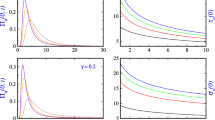Abstract
Using the integration method within an ordered product of operators, we present (anti-) normal products of the density operators of photon-subtracted displaced thermal states (PSDTSs) and their normalization factors, and investigate their nonclassical features via the photocount distribution and the negativity of Wigner distribution function. Also, we analytically and numerically investigate the time-evolution law and decoherence behaviors for amplitude decay. The results show that, for the PSDTSs, the smaller photon subtraction numbers m and thermal variance V and the appropriate displacement d can lead to the stronger nonclassicality, however the PSDTSs with large m show more robustness against decoherence because their initial negativity decreases more slowly.


Similar content being viewed by others
References
Iannaccone, G., Bonaccorso, F., Colombo, L.: Nat. Nanotechnology. 183191 (2018)
Huang, W., Qu, X., Yin, S.: IEEE. J Selected Topics in Quantum Electron, 1-7 (2020)
Arceci, L., Silvi, P., Montangero, S.: Phys. Rev. Lett., 128040501 (2022)
Anand, R.: Oral. Oncol., 125105704 (2022)
Lewis, H.R. Jr: J. Math. Phys., 1976-1986 (1968)
Jeong, H., Ralph, T.C.: Phys. Rev. Lett., 97100401 (2006)
Jeong, H., Paternostro, M., Ralph, T.C.: Phys. Rev. Lett., 102060403 (2009)
Łukasz, R., Walborn, S.P., Toscano, F.: Phys. Rev. A., 1-9 (2012)
Zheng, S.B., Guo, G.C.: Phys. Rev. Lett., 852392 (2000)
Imamoglu, A., Awschalom, D.D., Burkard, G.: Phys. Rev. Lett., 8320 (1999)
Wu, W.F.: Chinese J. Phys. (2015)
Zhang, R., Meng, X.G., Du, C.X.: J. Phys. Society Japan, 87024001 (2018)
Meng, X.G., Li, K.C., Wang, J.S.: Annalender Physik., 5321900585 (2020)
Meng, X.G., Wang, J.S., Zhang, X.Y.: Annalender Physik., 5322000219 (2020)
Fan, H.: J. Phys. A: General Phys., 231833-1839 (1990)
Cao, H., Ling, Y., Xu, J.Y.: Phys. Rev. Lett., 864524 (2001)
Davis, C.C., King, T.A.: J. Phys. A: General Phys., 3101 (1970)
Artoni, M., Ortiz, U.P., Birman, J.L.: Phys. Rev. A., 433954-3965 (1991)
Fan, H.Y., Lou, S.Y., Hu, L.Y.: Chin. Phys. Lett., 30090304 (2013)
Meng, X.G., Li, K.C., Wang, J.S.: Front. Phys., 151-11 (2020)
Liu, J.Y., Wang, A.P., Wu, M.Y.: Int. J. Theor. Phys., 603115-3127 (2021)
Meng, X, Goan, H.S., Wang, J.: Opt. Commun., 41115-20 (2018)
Butt, H.J., Jaschke, M.: Nanotechnology, 61 (1995)
Fischetti, M.V.: Phys. Rev. B., 594901 (1999)
Diosi L.A.: Phys. Lett. A., 120377-381 (1987)
Fan, H., Hu, L.: Modern Phys. Lett. B., 222435-2468 (2008)
Fan, H.: Phys. Rev. A., 65064102 (2002)
Hu, L.Y., Wang, Q., Wang, Z.S.: Int. J. Theor. Phys., 51331-349 (2012)
Cabrera, R., Bondar, D.I., Jacobs, K.: Phys. Rev. A., 92042122 (2015)
Acknowledgements
Project supported by the Natural Science Foundation of Shandong Province (Grant Nos.ZR2020MA085 and ZR2020MF113).
Author information
Authors and Affiliations
Corresponding author
Additional information
Publisher’s Note
Springer Nature remains neutral with regard to jurisdictional claims in published maps and institutional affiliations.
Appendices
Appendix A: Derivation of Normalization Factor \(\mathcal {N}_{m}\)
In order to obtain the factor \(\mathcal {N}_{m}\), we first use the formula
and the normal ordering product
to calculate the antinormal ordering product of ρ as
thus the normalization factor \(\mathcal {N}_{m}\) can be expressed as
Inserting the completeness relation of the coherent states \(\left \vert \alpha \right \rangle \) into Eq. A4 leads to
thus using the the mathematical integral formula
we can finally obtain the normalization factor\(\mathcal {N}_{m}\) in Eq. 4
Appendix B: Derivation of Eq. 16
Inserting the coherent representation of single-mode Wigner operator, i.e.,
and the normal ordering product of ρm in Eq. 7 into Eq. 15, and using the generating functions for Hermite polynomials in Eq. 10, we obtain
Further, using the integration formula in Eq. 11 leads to
Finally, we use the generating functions in Eq. 10 to derive Eq. 16.
Appendix C: Derivation of Eq. 25
In order to obtain Eq. 25, substituting Eq. 16 into the formula Eq. 24 and using the generating functions for Hermite polynomials in Eq. 10, we have
Using the integration formula in Eq. 11, thus Eq. C1 becomes
thus using the generating functions in Eq. 10, we finally obtain the result in Eq. 25.
Rights and permissions
Springer Nature or its licensor (e.g. a society or other partner) holds exclusive rights to this article under a publishing agreement with the author(s) or other rightsholder(s); author self-archiving of the accepted manuscript version of this article is solely governed by the terms of such publishing agreement and applicable law.
About this article
Cite this article
Wang, A., Meng, X. & Wang, J. Nonclassical Properties via Subtracting Photons from Displaced Thermal States and Decoherence Evolution for Amplitude Decay. Int J Theor Phys 61, 267 (2022). https://doi.org/10.1007/s10773-022-05248-x
Received:
Accepted:
Published:
DOI: https://doi.org/10.1007/s10773-022-05248-x



